- Home
- Media Kit
- Current Issue
- Past Issues
- Ad Specs-Submission
- Ad Print Settings
- Reprints (PDF)
- Photo Specifications (PDF)
- Contact Us

![]()
ONLINE

Where Philanthropy Begins at Home
It’s an oasis. It’s a refuge. It’s a place to find your inner self. And it is one of the finest garden properties in North America.
Wethersfield Garden occupies 1,200 acres in northeast Dutchess County, New York, where it is the highest point in the region with an elevation of 1,200 feet. From that vantage point, it offers majestic views of the Berkshires and Catskills. Comprised of a Georgian-style house – which serves as an art museum, classical gardens, a carriage house, and a farm – Wethersfield welcomes visitors from June to September.
Today, Wethersfield is the jewel in the crown of the Homeland Foundation. It was established in 1938 by Chauncey Devereux Stillman, a philanthropist and investor.
“Wethersfield is the definitive work that my grandfather, Chauncey Stillman, left to the world,” said Peter Budnik, who is at work on a chronicle of Stillman’s life. “My grandfather loved nature and wanted to preserve it. He loved art and architecture, and had a keen sense of order. And he was deeply religious.”
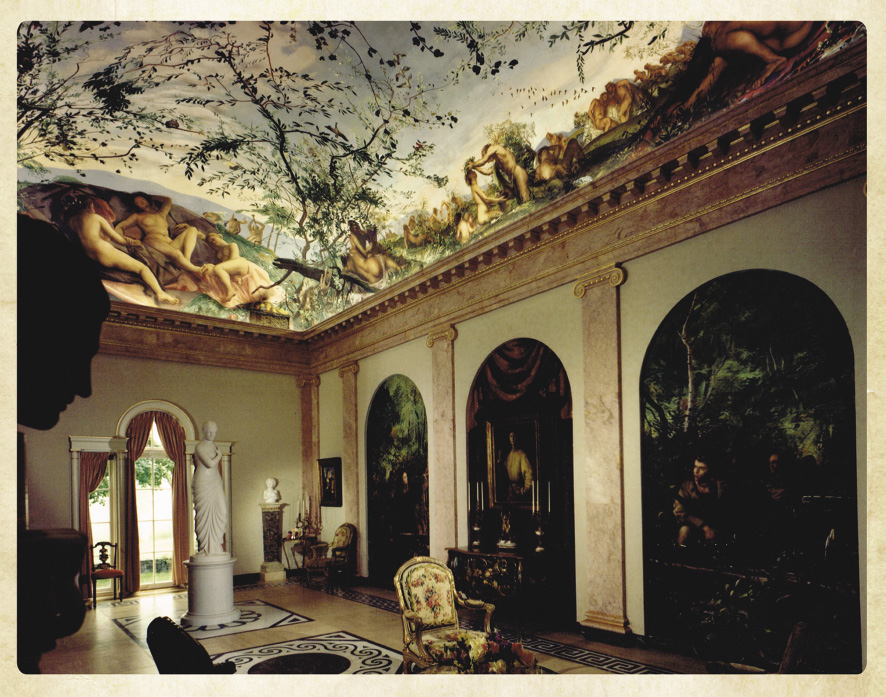
The striking Gloriette room in the House
at Wethersfield offers
an exquisite collection of paintings
and sculptures,
together with Baroque-style
frescoes by Italian artist Pietro Annigoni.
All of this is available to behold at the remarkable Wethersfield. To gain the richest possible appreciation of Wethersfield, it helps to know something of the life and character of Chauncey Stillman.
Stillman was a true Renaissance man, a man of parts – a rare phenomenon in today’s world. The Stillman character combined manly characteristics (he was a combat intelligence officer in World War II and later Commodore of the New York Yacht Club), intellectual curiosity (he was learned in everything from history and literature to soil and water conservation), and an extraordinary aesthetic sense (he loved fine art, horse-drawn carriages, classical gardens, and religious thought, and he possessed a fine sense of order).
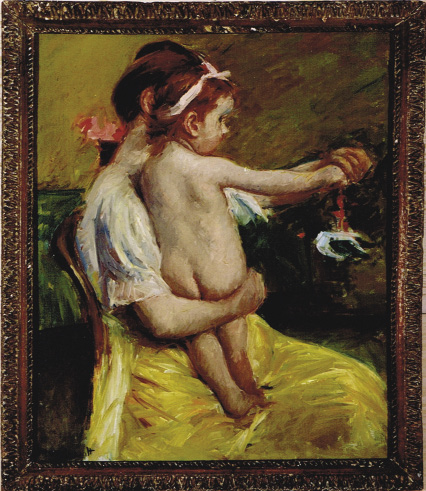
The painting, Mother Holding a
Nude Baby Playing with a Toy Duck,
by impressionist Mary Cassatt,
is one of Wethersfield’s treasured artworks.
For such a man, the meticulous acquisition of the parcels that make up Wethersfield, the careful planning of the property according to the best use of the soils and water resources, and an ingenious plan for buildings and gardens that perfected an incomparable natural setting, were a calling to which he committed himself completely.
Stillman purchased the original property, a dairy farm, and named it Wethersfield Farm after Wethersfield, Connecticut, where his ancestors had settled in the late 1600s. He began his enhancement of the property by addressing conservation and environmental issues. Under Stillman’s initiative, Wethersfield became one the first farms in Dutchess County to practice soil and water conservation. Stillman created 12 ponds on the property for drainage and irrigation and initiated reforestation procedures and the use of contour plowing and crop rotation. All of this was done as the Dust Bowl crisis continued in other parts of the United States.
An equine enthusiast, Stillman rode with the Millbrook Hunt. He decided in 1960 to introduce the art of carriage driving at Wethersfield. He acquired a collection of carriages, dating from 1850 to 1910, selecting the Hackney horse to drive them. Twenty miles of carriage roads were developed on the property and Stillman rode on them daily.
What makes Wethersfield such a magical place? Let’s take a tour and find out.
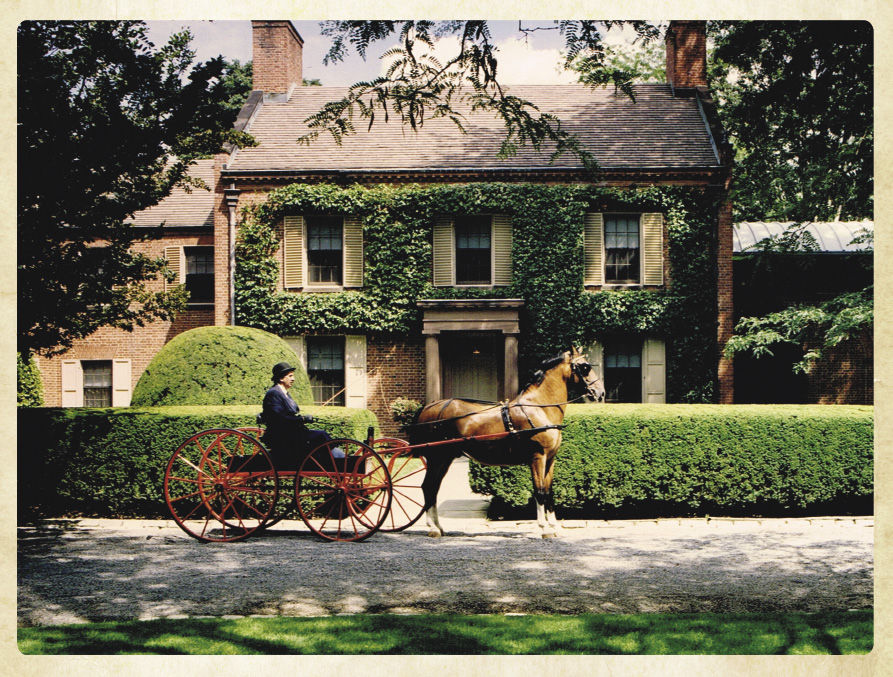
Wethersfield House, designed by architect Bancel LaFarge
in 1939, serves as a museum displaying the late
Chauncey Stillman’s world-class art collection.
The House is a good place to start. The Georgian revival, colonial brick building, while beautifully designed, is not particularly imposing from the outside. Inside, however, it is a feast for an esthete’s eyes. Designed by architect Bancel LaFarge in 1939, the House is configured so that the gardens outside align with the windows of the House, with views offering framed pictures of the prominent features of the surrounding formal Garden. But what attracts us when we enter the house are the stunning treasures assembled here.
The antiques, paintings, and sculptures in Chauncey Stillman’s dazzling collection date from the 15th to the early 20th century and include such paintings as Toulouse-Lautrec’s L’Enfant au chien, fils de Madame Marthe et la chienne, Mary Cassatt’s Mother Holding a Nude Baby Playing with a Toy Duck, Bartolome Esteban Murillo’s Madonna and Child, and a Gilbert Stuart portrait of George Washington, together with sculptures by Antonio Canova and Joseph Stachura.
The striking South Wing, or “Gloriette,” was designed by architect George F. Poehler and completed in 1973 as a one-room extension to the entrance façade of the House. It is a somewhat smaller, more intimate version of a large ballroom found in a beaux arts mansion. Stillman’s sense of order is again evident in the design of the Gloriette, which includes a collection of paintings and sculptures. A feature that invariably pleases visitors is the display of Baroque-style frescoes by Italian artist Pietro Annigoni. Stillman and Annigoni were friends, and one of the frescoes includes whimsical views of the two men together in the forest.
Stepping outside into the Garden, we begin to get a feeling for its natural beauty, proportion, and meditative quality.Wethersfield Garden is a three-acre formal garden created by Stillman. It was designed on an east/west and north/south axis and was claimed from sloping pasture land and fields.
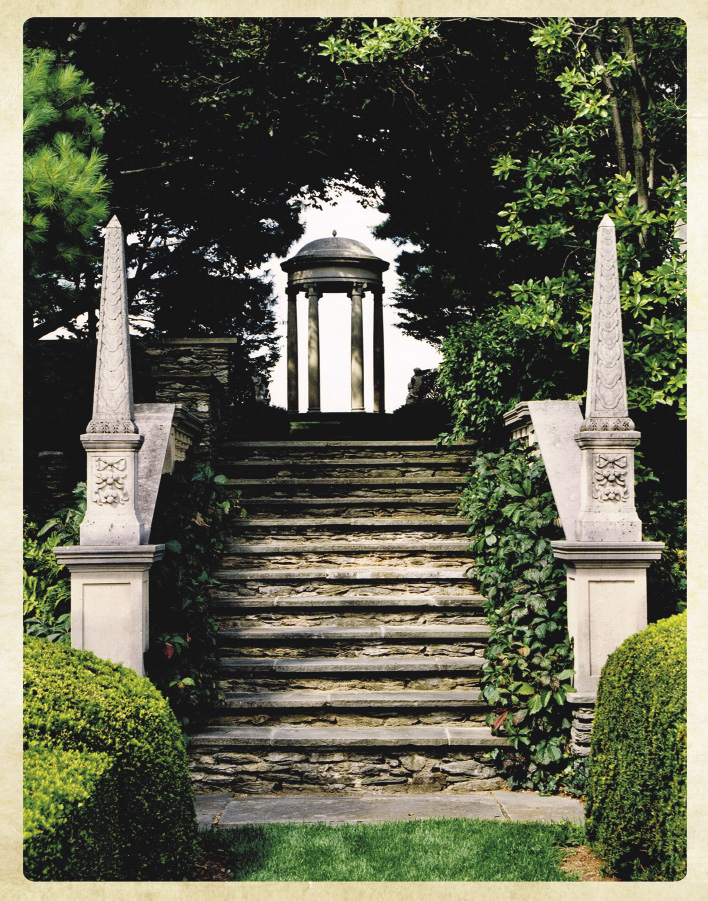
The Belvedere in Wethersfield Garden
beckons visitors to climb the steps and take
in
spectacular views of the surrounding countryside.
The inspiration for Stillman was the garden of the Italian Renaissance and its use of water, sculpture, topiary, and terraces. The Garden began on the north side of the house, when landscape architect, Bryan J. Lynch and Stillman created the Inner Garden from 1940 to 1941 in the 19th Century English style.
The remaining Garden was created over a 25-year period beginning in 1947 when Stillman retained landscape architect, Evelyn N. Poehler. It is a garden of landscape architecture, different shades of green, and varying textures of plant material.
The presence of water in the Garden enhances the vistas by elongating the views and creating tranquil sounds. In the intimate Inner Garden, dolphin-shaped fountains spout into a long narrow canal.
Throughout the Garden are sculptures created by deMarco, Watts, Flannagan, and Stachura, several with religious themes. The Garden blends these formal elements with those found in the native landscape.
Architectural features including a terrace or statues and urns work as visual nodes, while flowers play a role in accenting and provide contrast for these focal points, as well as exotic trees, such as orange and gardenia. The Arborvitae Allée and the Peacock Walk are two of the Garden’s inviting walkways. Looking down these greenery-lined corridors, our eyes are drawn to distant objects such as the Naiad Fountain or the Belvedere.
Wethersfield’s Garden is a place to retreat from the busy world for a time and to indulge in its tranquil mood. The bubbling and rippling of the water in the ponds enhances a visitor’s detachment. In this beautiful, ordered haven, one can refresh, contemplate, and pray. And to encourage creativity, there is no more inspirational setting than the Garden.
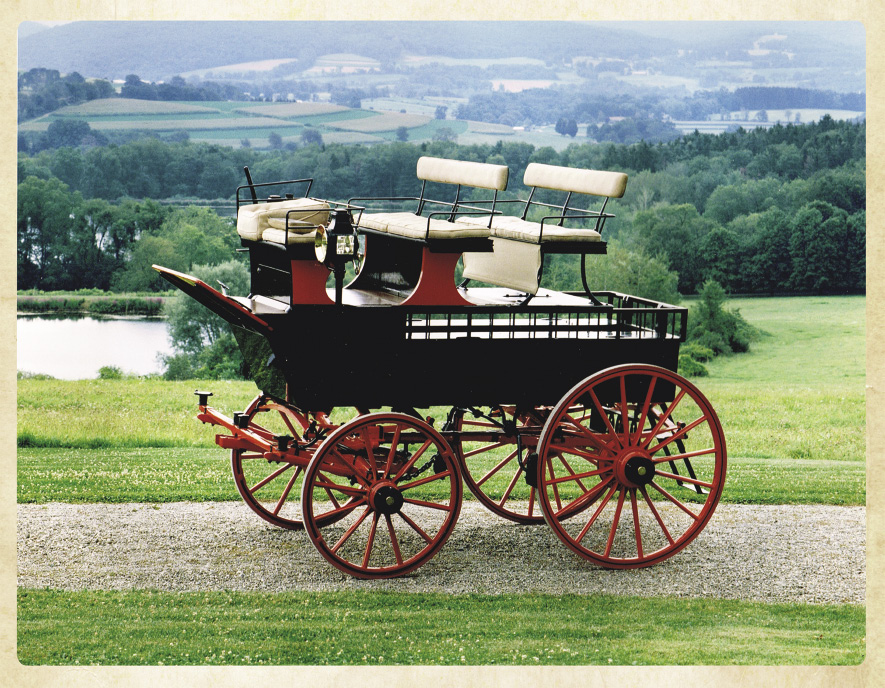
The lush trees and fields of
Dutchess County form
a perfect backdrop for this
Brewster & Company Wagonette Break, built in 1900.
Now, let’s take a short trip down to the Carriage House. Stillman, an accomplished equestrian enthusiast, built Wethersfield Stables in 1937 to house riding horses for fox hunting and recreation. In 1960, Stillman took an interest in reviving the declining art of carriage driving and the stables were expanded to accommodate Hackney horses and a Carriage House.
Stillman worked closely with Colonel Paul Downing, a consultant for Colonial Williamsburg and founding editor of The Carriage Journal, in developing his carriage collection and acquiring the appropriate appointments and harness. Over the years, 22 carriages were acquired and meticulously restored. Each carriage is shiny and perfectly maintained. The Stillman family crest, in brass, is often attached to harnesses. Either the crest, the Stillman family monogram, or crossed yacht flags are painted on the carriages.
All of the carriages in the collection date from 1850 to 1910. The collection features a Park Drag and George IV Phaeton by Brewster & Co., New York; a Roof Seat Break by A.S. Flandrau & Co., New York; and a Barouche by Barker & Co., London. A variety of sporting and formal carriages are also included.
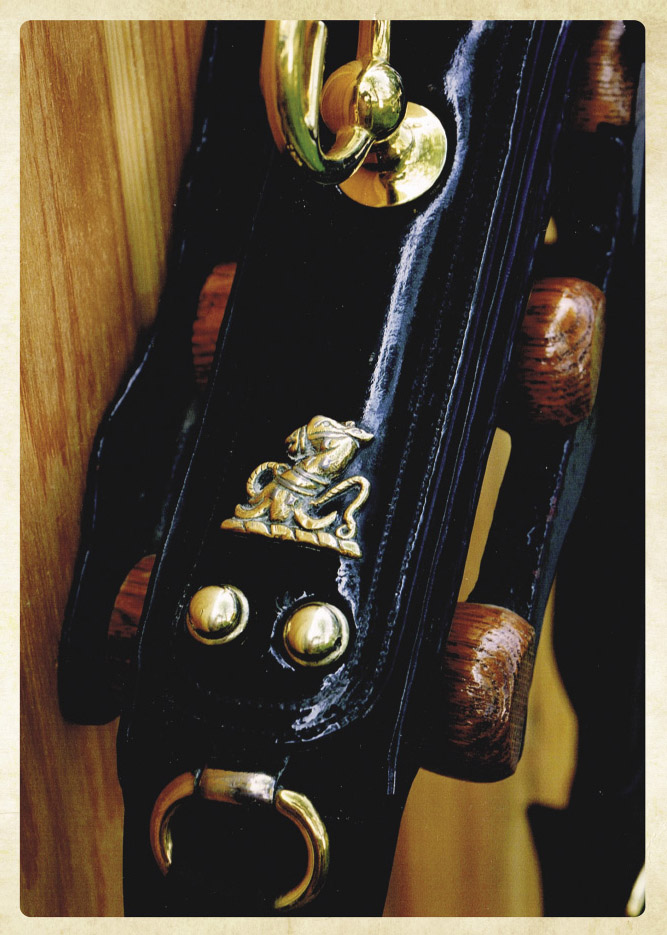
The Stillman family crest is
attached to a saddle pad in the
Wethersfield Carriage House.
House guests at Wethersfield were treated to daily carriage rides along the nearly 20 miles of carriage trails on the estate. From 1960 to 1976, Stillman and his team of whips and stablemen participated in and dominated driving competitions at Newport, Devon, Springfield, and Toronto. Throughout his lifetime, he also hosted several carriage driving events at Wethersfield. On two occasions, Stillman was invited to provide postillion-style coaches for the opening ceremony of the Royal Winter Fair in Toronto. In 1967, a coach provided by Stillman carried Prince Philip, Duke of Edinburgh, and in 1974, a second coach carried Princess Anne and her husband, Capt. Mark Phillips.
The Farm is a facet of Wethersfield that takes the property back to its roots in 1937, when Chauncey Stillman purchased two adjacent dairy farms covering approximately 600 acres.Wethersfield was one of the first farms in Dutchess County to practice soil and water conservation. Early conservation practices included pasture improvement, improved drainage of lowlands, terracing steep slopes, and woodlot improvement.
As an early member of the Dutchess County Soil Conservation District, Wethersfield hosted a tour of the farm as an excellent example of conservation practices to delegates attending the United Nations Scientific Conference on the Conservation and Utilization of Natural Resources sponsored by the American Citizens Committee and the National Association of Conservation Districts on August 20, 1949. Today, farming at Wethersfield is carried on in the same tradition, and both field crops and livestock are produced.
We have one more feature of Wethersfield to visit: the Wilderness, a seven-acre wooded area located southwest of the House and looped by a carriage drive. Chauncey Stillman built the network of trails for his equestrian pursuits, and they were later expanded and used for carriage driving.
While the Wilderness is a natural setting less formally organized than the Garden, Stillman’s sense of order is very much in evidence. He had statues installed, and rhododendron and mountain laurel planted in the existing wooded area. Hawks sitting on pillars framing a shallow pool with a vertical spout mark the entrance to the Wilderness. English sculptor Peter Watts and Polish-born sculptor Joseph Stachura created 16 statues during the late 1960s and 1970s that embellish the Wilderness.
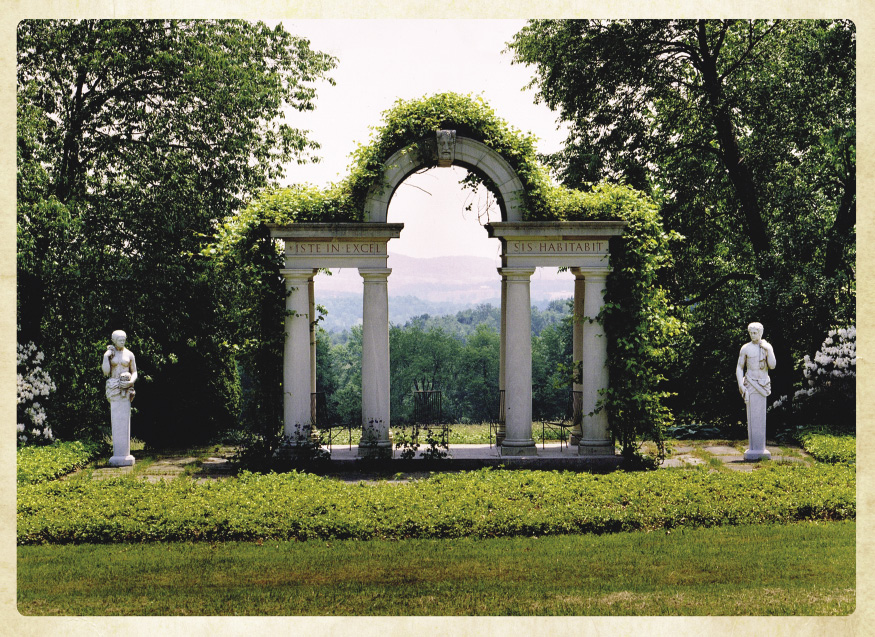
The classical Palladian Arch divides the formal Garden and
the more natural Wilderness area at Wethersfield.
A striking feature that divides the formal Garden and Wilderness is the Palladian Arch, a limestone structure inspired by the 18th-century neoclassical Italian architecture of Palladio. While it occupies a distant location on the property, it can be clearly seen from any of the southern windows of the House.
Today, Wethersfield is a Dutchess County landmark and a destination that is a vital part of the immediate community.
As Elizabeth Wyckoff, President of the Board of Trustees of the Homeland Foundation, said: “We want Wethersfield to enrich the lives of people who visit it and to offer programs and events that will appeal to their higher aesthetic and spiritual sense. Going forward, we will endeavor to develop programs that will make significant and effective contributions to the local community.”
Local leaders and neighbors regard the farm and garden as a highly valued community asset. David Tetor, former Cornell Extension Agricultural Agent and former Stanford Town Supervisor, has memories of Wethersfield that go back several decades.
”Since the Foundation has taken over the management of Wethersfield from Mr. Stillman, they have done a very good job. It is well maintained and in spotless condition today,” Tetor said.
Farnham Collins, former Master of the Millbrook Hunt, also has a long history with the property. “Wethersfield is a beautiful property and clearly an asset to this whole community,” he said. “It has agricultural activities and equestrian activities and it has been well-maintained for decades. I think they maintain the place just as well as they did during Mr. Stillman’s lifetime.
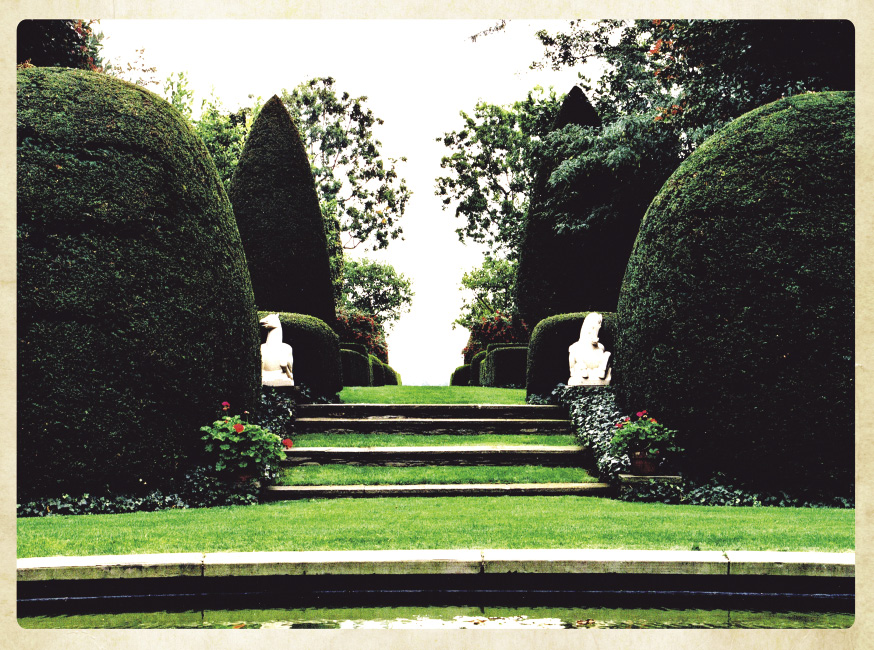
Looking east across the reflecting pool
in the Garden, our eyes are treated to a view
of paired stone horses and Japanese yew.
“The Millbrook Hunt held events at Wethersfield and Mr. Stillman hunted in the ’30s, ’40s, and ’50s. Wethersfield still opens the property for those activities. The Homeland Foundation’s interest in the community today is focused almost entirely on the Wethersfield property.”
A newer local resident is Soo Kim, who owns property adjoining Wethersfield. “Wethersfield represented an outdoor museum for Chauncey Stillman.” Kim said. I think that his original desire to preserve the environment has been captured in Wethersfield.
“You lead by action and Mr. Stillman acted to preserve the property in a natural state for the community. In my own way, I try to do the same with my property. So I am trying to live up to Mr. Stillman’s idea by acting to preserve the natural beauty of my own property.
“The staff at Wethersfield are great. I can’t say enough about the work of the Homeland Foundation here.”
Elizabeth Wyckoff is looking to the future for Wethersfield and to how the Homeland Foundation can serve the surrounding community.
“We have some exciting plans in the works,” she said. “We are seeking to enhance our equestrian facilities and to increase their use by the immediate community. Going forward, we will endeavor to develop programs that will make significant and effective contributions to local entities. We will be partnering with other community organizations to identify and support the most worthy causes consistent with Homeland’s purpose. We will be participating in the Garden Conservancy’s nationally recognized Open Days Program, with a June 30 event at Wethersfield; we are exploring possibilities of using Wethersfield as an outdoor classroom in which children can learn about nature, science, art, music, and literature; we are initiating a Friends and Sponsors of Wethersfield program giving special benefits to those who wish to support us at different levels; and we are planning a performing arts series. We are also working towards securing Wethersfield as a National Historic Landmark by the National Park Service. My goal is to share our treasure and give others the opportunity to enhance their appreciation for the aesthetic and spiritual consciousness that inspired Mr. Stillman’s ultimate artistic creation.”•